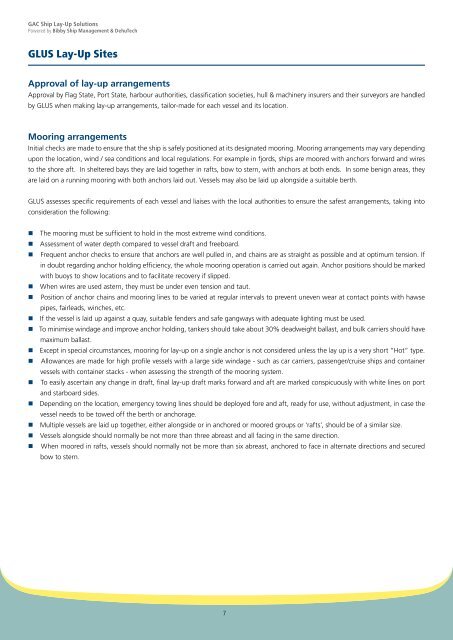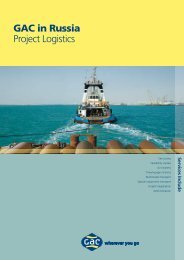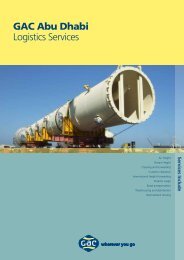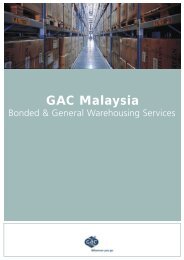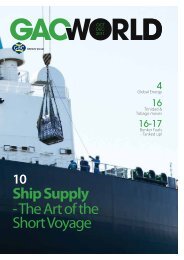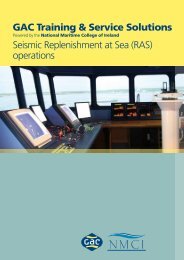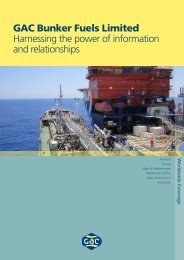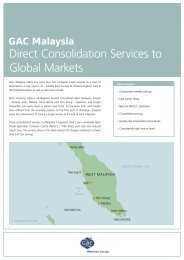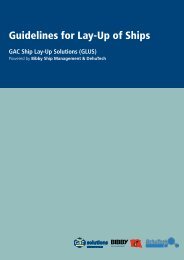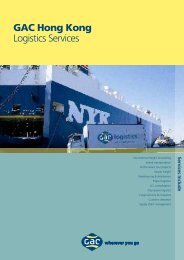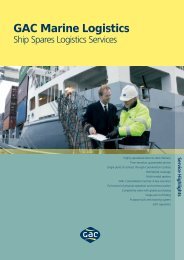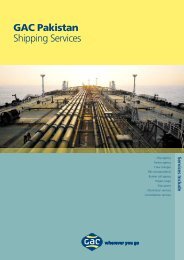Ship Lay-Up Guidelines - GAC
Ship Lay-Up Guidelines - GAC
Ship Lay-Up Guidelines - GAC
You also want an ePaper? Increase the reach of your titles
YUMPU automatically turns print PDFs into web optimized ePapers that Google loves.
<strong>GAC</strong> <strong>Ship</strong> <strong>Lay</strong>-<strong>Up</strong> Solutions<br />
Powered by Bibby <strong>Ship</strong> Management & DehuTech<br />
GLUS <strong>Lay</strong>-<strong>Up</strong> Sites<br />
Approval of lay-up arrangements<br />
Approval by Flag State, Port State, harbour authorities, classification societies, hull & machinery insurers and their surveyors are handled<br />
by GLUS when making lay-up arrangements, tailor-made for each vessel and its location.<br />
Mooring arrangements<br />
Initial checks are made to ensure that the ship is safely positioned at its designated mooring. Mooring arrangements may vary depending<br />
upon the location, wind / sea conditions and local regulations. For example in fjords, ships are moored with anchors forward and wires<br />
to the shore aft. In sheltered bays they are laid together in rafts, bow to stern, with anchors at both ends. In some benign areas, they<br />
are laid on a running mooring with both anchors laid out. Vessels may also be laid up alongside a suitable berth.<br />
GLUS assesses specific requirements of each vessel and liaises with the local authorities to ensure the safest arrangements, taking into<br />
consideration the following:<br />
n The mooring must be sufficient to hold in the most extreme wind conditions.<br />
n Assessment of water depth compared to vessel draft and freeboard.<br />
n Frequent anchor checks to ensure that anchors are well pulled in, and chains are as straight as possible and at optimum tension. If<br />
in doubt regarding anchor holding efficiency, the whole mooring operation is carried out again. Anchor positions should be marked<br />
with buoys to show locations and to facilitate recovery if slipped.<br />
n When wires are used astern, they must be under even tension and taut.<br />
n Position of anchor chains and mooring lines to be varied at regular intervals to prevent uneven wear at contact points with hawse<br />
pipes, fairleads, winches, etc.<br />
n If the vessel is laid up against a quay, suitable fenders and safe gangways with adequate lighting must be used.<br />
n To minimise windage and improve anchor holding, tankers should take about 30% deadweight ballast, and bulk carriers should have<br />
maximum ballast.<br />
n Except in special circumstances, mooring for lay-up on a single anchor is not considered unless the lay up is a very short “Hot” type.<br />
n Allowances are made for high profile vessels with a large side windage - such as car carriers, passenger/cruise ships and container<br />
vessels with container stacks - when assessing the strength of the mooring system.<br />
n To easily ascertain any change in draft, final lay-up draft marks forward and aft are marked conspicuously with white lines on port<br />
and starboard sides.<br />
n Depending on the location, emergency towing lines should be deployed fore and aft, ready for use, without adjustment, in case the<br />
vessel needs to be towed off the berth or anchorage.<br />
n Multiple vessels are laid up together, either alongside or in anchored or moored groups or ‘rafts’, should be of a similar size.<br />
n Vessels alongside should normally be not more than three abreast and all facing in the same direction.<br />
n When moored in rafts, vessels should normally not be more than six abreast, anchored to face in alternate directions and secured<br />
bow to stern.<br />
7


